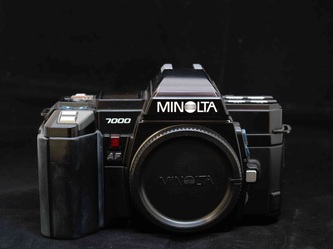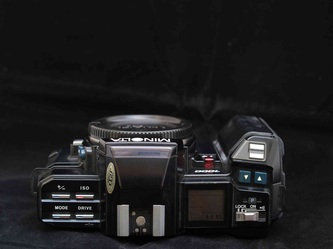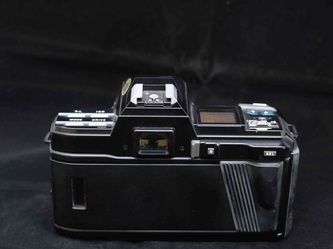Minolta 7000
This is a camera that ought to be present in every camera collection. Of course not because it's very rare or of high value. But because it's the camera which changed the world of SLR's from manual focus to autofocus. In 1985 Minolta was not the first to introduce an autofocus SLR, but they were the first to do so in a compact body with normal-size lenses. But not only they made focussing automatic, they also introduced a built in winder and programmed exposure. Classic buttons were replaced by electronically controlled buttons, and the metal body was replaced by a body made of plastics (though durable plastics).
One big downside of the introduction of the 7000 was the fact that Minolta dropped the MD mount of the manual focus lenses and introduced a new A mount (still the same on todays Sony's). Manual focus lenses didn't fit to the new AF body. This marked the end of the manual focus bodies of Minolta and the end of the MD lens line-up. Photographers who wanted to upgrade to AF didn't have to stick to Minolta. They could change to another brand, because all the big brands introduced AF shortly after Minolta. For myself this meant I changed from Minolta to Canon. Despite all this the 7000 was a real hammer in sales, and it made Minolta big for a while.
For todays practical use this sure isn't your camera. Though pretty durable and reliable it's got to many downsides. First AF is sloooow. Second AF is not fast, no sir not fast at all. Third all those flimsy pushbuttons are a pain to use. Fourth programshift wasn't invented yet, which means exposure is completely at the mercy of the camera. In conclusion: if you still want to shoot film, look for a more modern AF SLR. Like the 7000 they also sell for nothing and less.
One big downside of the introduction of the 7000 was the fact that Minolta dropped the MD mount of the manual focus lenses and introduced a new A mount (still the same on todays Sony's). Manual focus lenses didn't fit to the new AF body. This marked the end of the manual focus bodies of Minolta and the end of the MD lens line-up. Photographers who wanted to upgrade to AF didn't have to stick to Minolta. They could change to another brand, because all the big brands introduced AF shortly after Minolta. For myself this meant I changed from Minolta to Canon. Despite all this the 7000 was a real hammer in sales, and it made Minolta big for a while.
For todays practical use this sure isn't your camera. Though pretty durable and reliable it's got to many downsides. First AF is sloooow. Second AF is not fast, no sir not fast at all. Third all those flimsy pushbuttons are a pain to use. Fourth programshift wasn't invented yet, which means exposure is completely at the mercy of the camera. In conclusion: if you still want to shoot film, look for a more modern AF SLR. Like the 7000 they also sell for nothing and less.
| maxxum7000manual-part1.pdf | |
| File Size: | 2314 kb |
| File Type: | |
| maxxum7000manual-part2.pdf | |
| File Size: | 2582 kb |
| File Type: | |



